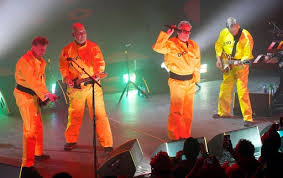
NEW YORK — You know the band Devo, right? The guys with the funny red plastic hats and jumpsuits? The New Wave musicians behind the silly “Whip It” video? They had that odd, spiky ‘80s vibe? Well, it turns out you may not know as much as you think.
The new Netflix documentary “Devo” is an eye-opening examination of an Ohio-born art-rock band that argues they were perhaps the most misunderstood band on the face of the planet. It debuts on the streaming service Tuesday.
“We were trivialized and pigeonholed,” co-founder Gerald Casale tells The Associated Press. “This documentary allows us to talk about what we were thinking and what we are motivated by to create what we created.”
Directed by Chris Smith, “Devo” uses archival footage and interviews to trace the band’s beginnings, rise and fall, with cameos from fans like David Bowie, Iggy Pop and Neil Young.
‘What we saw was regression’
Devo introduced themselves to the world in 1977 by making a frenetic version of the Rolling Stones’ “I Can’t Get No) Satisfaction,” which earned them a crucial slot on “Saturday Night Live.” On stages, they would wriggle like worms or dress like the guys from “Ghostbusters.”
They released their Brian Eno-produced debut, “Q: Are We Not Men? A: We Are Devo!,” in 1978 and reached platinum status with 1980’s “Freedom of Choice,” which featured “Whip It,” a hit just as their label was getting ready to drop them.
But behind the odd neck braces and knee pads were powerful art and literary ideas about where the country was going. They named themselves after the idea that modern society was entering a process of “devolution.”
“We were seeing a world that was the antitheses of the idealized, promised future ginned up in the ’50s and ’60s.” Casale says in the movie. “What we saw was regression.”
The nucleus of the band was formed from tragedy: Casale and Mark Mothersbaugh met at Kent State University, where they lived through the 1970 killing of four unarmed anti-war student protesters by the National Guard.
That tragedy forged in the pair an antiestablishment, anti-capitalist protest, mixing lofty art history with pop culture. They admired Dadaism and Andy Warhol. The factories of Akron inspired their gray overalls and clear plastic face masks — portraying cogs in a machine like in the art movie “Metropolis.”
“We had a meta-approach,” Casale tells the AP. “It was a multimedia, big idea approach. Music was an element, a layer, a dimension, but it was connected to this big worldview.”




